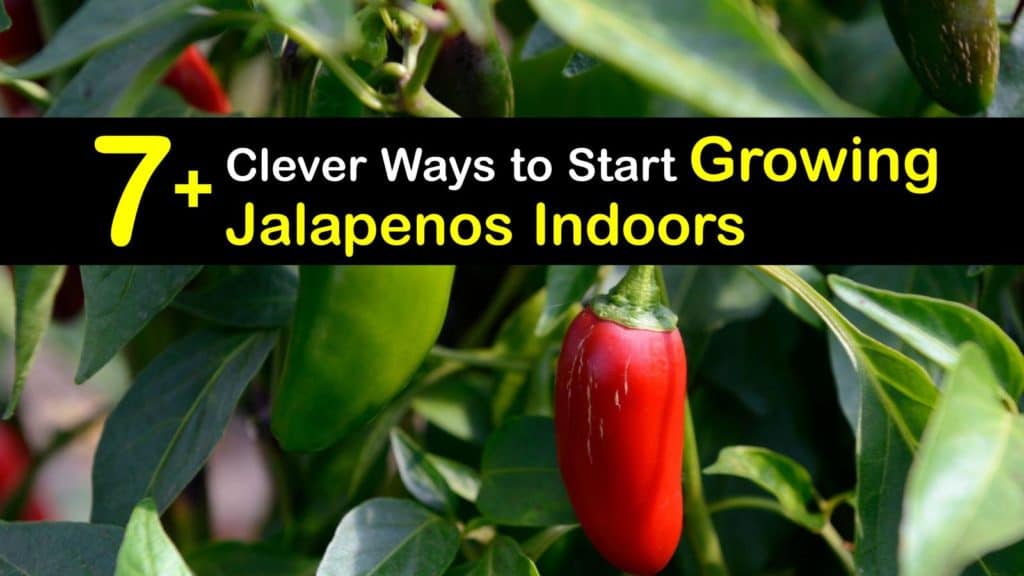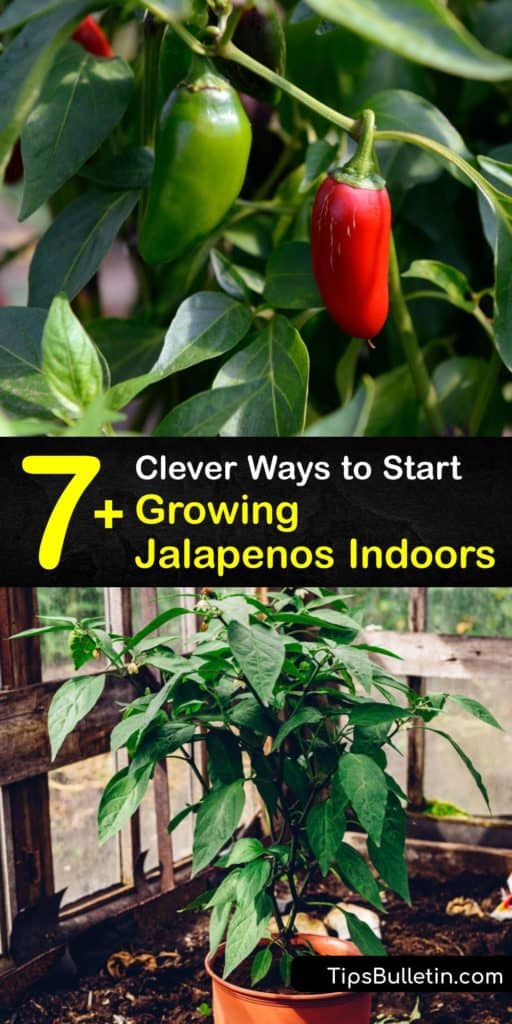Gardening is a fulfilling hobby that gives you the gratifying reward of bringing your hard work indoors. However, your location and climate may be factors working against you perfecting your green thumb. Jalapenos are plants known for their hardiness in warmer conditions; if it’s below 70 degrees Fahrenheit where you live, it’s time to learn about growing jalapenos indoors.
Jalapenos (Capsicum annum), like other pepper varieties such as serrano or bell pepper, are perennial plants that continue to grow and produce fruits for five years as indoor plants. Jalapenos share the ability to self-pollinate with other plants like the habanero pepper and cayenne pepper plants.
If you’re looking to add spice to your meals, jalapenos are the most popular choice for adding heat without missing flavor. With an average rating of 5,000 on the Scoville scale, jalapenos are among the more mild varieties of chili peppers.
This article details how to grow jalapenos indoors and tips to ensure you have the best harvest year after year.

- How to Grow Jalapenos Indoors
- Growing Jalapenos Indoors from Seeds
- Growing Jalapenos in Pots for Transplanting
- Lighting Indoor Jalapeno Plants
- Caring for the Soil of your Jalapeno Plant
- Fertilizing Your Jalapeno Plants
- Watering Jalapeno Pepper Plants
- How to Know when Jalapenos are Ready to be Harvested
- Addressing Legginess When Growing Jalapenos in Pots
- Companion Planting for Jalapeno Plants
- How to Grow Jalapenos at Home through Propagation
- Pests on Potted Plants
How to Grow Jalapenos Indoors
Jalapeno pepper plants are simple fruits to grow indoors and are a handy ingredient in the kitchen to add flavor to a dish. Growing green peppers indoors is just as easy.
For anyone who enjoys spice in their cooking, nothing beats having a fresh supply of homegrown peppers in your windowsill ready for use. Once you know how to grow jalapenos indoors, you’ll never be without your favorite pepper flavor, no matter what jalapeno types you choose.
Growing Jalapenos Indoors from Seeds
Without the worry of frost on your mind, you’re free to plant jalapenos year round without concern for jalapeno season.
When growing habaneros indoors or jalapenos, place two seeds ¼ inch deep in a three-inch pot, fill with a soilless mix, and water thoroughly.
As your jalapeno pepper plants begin to grow, transfer them into larger pots, either two or five gallons, and fill them with well-draining potting soil. Harvest your hot peppers when they are ready to continue growing jalapenos indoors.

Growing Jalapenos in Pots for Transplanting
If you’re growing jalapenos in containers with the foresight to plant them in the garden, sow your jalapeno pepper seeds two months before their transplant date. Use the same process – plant two seeds in a three-inch pot, fill with potting mix, and water well.
As germination occurs, harden your plant to acclimate it to the conditions of your garden. Begin leaving your pot outside for an hour each day, for a maximum of seven hours before transplanting. Do not transplant before the last frost in your area passes.
Lighting Indoor Jalapeno Plants
When growing jalapenos in pots, it’s essential they receive full sun by placing your pots on a sunny windowsill for a minimum of eight hours. If getting adequate sun on your pepper seeds is an issue, put your pots two to four inches below a grow light.
If your plant is growing in a windowsill, rotate the pot a quarter of a turn every four days and as your seeds germinate, remove the weakest seed.
Once fully developed, provide your plant with 16 hours of light a day for optimum lighting conditions by allowing your plant to sit in natural sunlight and providing artificial light through a grow light.
Caring for the Soil of your Jalapeno Plant
Jalapeno peppers require a soil temperature of at least 70°F to germinate. If your home temperature is below 70°F, place a heating pad under your pot to warm the soil. Monitor soil temperature with a thermometer and remove the heating pad or lower the settings if the soil gets above 80°F.
Fertilizing Your Jalapeno Plants
Feeding your jalapeno plants may not be necessary if the soil is rich in nutrients, but plants growing in containers benefit from the help. Fertilize your jalapeno plants with a balanced fertilizer every three weeks for nutrients or add compost made of organic matter to the base of your plant as blossoms begin to form.
Watering Jalapeno Pepper Plants
Jalapeno plants require a lot of water for healthy growth. Water them thoroughly to start and again whenever the soil feels dry about an inch down.
When you start planting or are replanting into larger containers, ensure there is good drainage in your pot and that you do not allow your plant to become waterlogged. Adding a thick layer of mulch to your pot, indoors or outdoors, helps keep your soil moist.
How to Know when Jalapenos are Ready to be Harvested
Do you know when to pick jalapeno peppers? With proper plant care, once your jalapenos take on a firm texture and their signature dark green color, you know it is time to harvest. Cut or pluck the pepper from the plant. Check your plant often for peppers ready for harvesting to encourage growth and future produce.
If you miss harvesting a pepper and the pepper begins to take on a red color, your pepper’s flavor profile has changed slightly. This extra time on the plant gives your jalapeno a sweeter flavor, making it less hot.
Explore the many ways to store jalapeno peppers after you pick them, from pickling to drying, for use in many recipes.
Addressing Legginess When Growing Jalapenos in Pots
A plant becoming leggy, growing more stem than leaf, means your plant may not have enough exposure to sunlight and is growing taller to make up for it. Plants may become too tall and flop over without proper strength in their roots and stems.
Leggy plants produce poor yields, and addressing any legginess in your indoor jalapeno plant is essential to continued growth.
Discourage legginess by brushing and fanning your jalapeno plant to simulate its growing conditions as if it were growing outdoors. Touching the top of your plants with your hands encourages stockier growth and prevents them from becoming leggy.
Fanning your plant helps avoid damping off, an ailment that affects seedlings from a soil-borne fungal disease that preys on damp low-air-circulation conditions.
Companion Planting for Jalapeno Plants
Companion planting is a great way to ensure you’re getting the best return on investment after transplanting. Increase the flavor and yield of your plant and keep away pests like aphids by planting your jalapeno plant adjacent to beneficial plants.
Among these suggestions, our vote goes to the tomato plant. Not only do the two go together well in salsa, but as partners in planting, jalapenos and tomatoes benefit each other toward a successful harvest.
Grow jalapenos and tomatoes in a raised container with your tomato seedlings planted in the center, 12 inches apart. Plant the jalapenos seedlings at the front of the container, six inches from the edge and 12 inches apart from each other. This placement puts your jalapenos in front of and between the centered tomato plants.
How to Grow Jalapenos at Home through Propagation
If you mastered the DIY indoor jalapeno garden and are looking to expand without buying more seeds or a nursery plant, consider propagating your jalapeno plant from cuttings. Cuttings allow you to start a new plant from another plant that you know has excellent yields.
Find a stem between four and six inches in length to cut at a 45° angle below the leaf. Remove any leaves, fruit, or flowers from the lower half of your cutting and dip the cut end into a rooting hormone.
Fill a small container with soilless mix and plant your cutting. Water well and keep the pot warm and on a sunny windowsill. Like when growing from seeds, jalapeno cuttings require soil around 70°F.
Roots form in about two weeks; then, your new jalapeno plant is ready for transplanting into the outdoor garden or into a bigger pot to continue its indoor growth.
Pests on Potted Plants
Although your jalapeno plants may seem safe from pests indoors, potted plants attract bugs like any plant in the garden would. The most significant benefit of indoor planting for your jalapeno plants in terms of pests is that you are likely to deal with fewer insects.
How to Get Rid of Pests when Growing Jalapenos Indoors
When growing plants indoors, the room you’ve chosen as your indoor garden may have high humidity, and the area around your plant may be humid from when you last watered. Humidity creates an ideal spot for insects to gather.
If your jalapeno growing journey started with a nursery plant, you might have unknowingly introduced bugs into your home.
A lack of natural predators may allow the insect problem to foster around your plants. Without lacewings or lady beetles, for example, aphids may have free range to your plants.
Maintaining good air circulation around your plants keeps mold from forming on leaves and deters pests from finding places to land and thrive. Creating a DIY insecticide spray is another method to rid yourself of pests.
Combine water, rubbing alcohol, and mild liquid dish soap in a spray bottle and spritz onto your jalapeno plant. Rubbing alcohol kills any present pests, while the added water prevents it from damaging your plant and leaves. The addition of soap helps the solution stick to the leaves to prevent more pests from landing.

Now that you’re armed with knowledge on growing jalapenos indoors, we hope you’re inspired to begin growing jalapenos in pots and will share these tips with friends and family on Facebook and Pinterest.